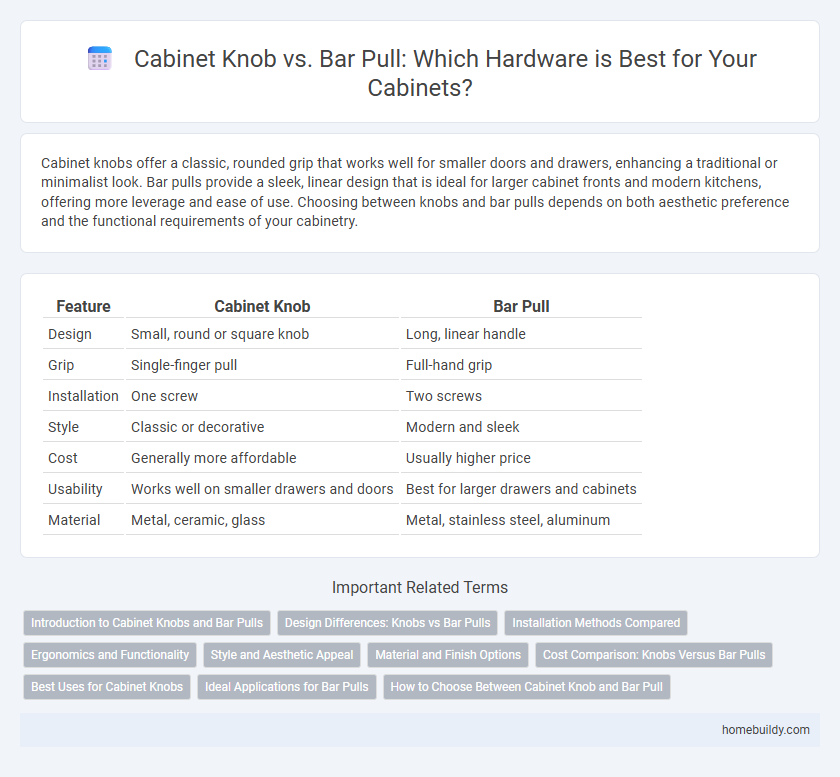Cabinet knobs offer a classic, rounded grip that works well for smaller doors and drawers, enhancing a traditional or minimalist look. Bar pulls provide a sleek, linear design that is ideal for larger cabinet fronts and modern kitchens, offering more leverage and ease of use. Choosing between knobs and bar pulls depends on both aesthetic preference and the functional requirements of your cabinetry.
Table of Comparison
| Feature | Cabinet Knob | Bar Pull |
|---|---|---|
| Design | Small, round or square knob | Long, linear handle |
| Grip | Single-finger pull | Full-hand grip |
| Installation | One screw | Two screws |
| Style | Classic or decorative | Modern and sleek |
| Cost | Generally more affordable | Usually higher price |
| Usability | Works well on smaller drawers and doors | Best for larger drawers and cabinets |
| Material | Metal, ceramic, glass | Metal, stainless steel, aluminum |
Introduction to Cabinet Knobs and Bar Pulls
Cabinet knobs offer a classic, compact option for furniture hardware, typically featuring a single attachment point and round or decorative shapes that complement various interior styles. Bar pulls provide a modern, elongated design with two mounting points, offering a sturdy grip and a streamlined look ideal for contemporary or industrial-themed cabinets. While knobs emphasize simplicity and versatility, bar pulls prioritize functionality and aesthetics in larger or more frequently used cabinet doors and drawers.
Design Differences: Knobs vs Bar Pulls
Cabinet knobs are typically small, round or square fixtures offering a classic, minimalist look that complements traditional and transitional cabinetry styles. Bar pulls, in contrast, feature elongated, linear designs that provide a modern, sleek aesthetic suitable for contemporary and industrial kitchens. The choice between knobs and bar pulls significantly impacts the overall kitchen design by influencing the perceived scale, style, and ergonomics of cabinet hardware.
Installation Methods Compared
Cabinet knobs require a single hole installation, making them easier and faster to install compared to bar pulls, which need two holes aligned perfectly for proper mounting. Bar pulls often involve more precise measurements and additional hardware, increasing installation time and complexity. Knobs offer a simpler, more flexible installation method suitable for DIY projects and minimal cabinet modifications.
Ergonomics and Functionality
Cabinet knobs offer precise grip points that enhance control and ease of use, especially in smaller or tight spaces, promoting ergonomic comfort. Bar pulls provide a larger surface area for hand engagement, accommodating various grip styles and making them ideal for heavy or frequently used drawers and cabinets. Both options improve functionality, but the choice depends on user preference for grip type and the frequency of cabinet access.
Style and Aesthetic Appeal
Cabinet knobs offer a classic, versatile style that complements traditional and transitional kitchen designs, adding subtle elegance with their rounded or ornate shapes. In contrast, bar pulls provide a sleek, modern aesthetic favored in contemporary and minimalist spaces, emphasizing clean lines and a streamlined look. Choosing between knobs and bar pulls depends largely on the desired overall style and visual impact, with knobs enhancing warmth and detail, while bar pulls contribute to a polished, sophisticated vibe.
Material and Finish Options
Cabinet knobs typically offer a wider variety of material choices including brass, ceramic, glass, and stainless steel, allowing for versatile design applications. Bar pulls often emphasize sleek metal finishes such as brushed nickel, matte black, and chrome, which complement modern and contemporary cabinetry styles. Both hardware types feature durable coatings that resist tarnishing and wear, enhancing longevity and aesthetic appeal.
Cost Comparison: Knobs Versus Bar Pulls
Cabinet knobs generally offer a more cost-effective option compared to bar pulls due to their smaller size and simpler design. Bar pulls often have higher material and installation costs, making them more expensive overall. For budget-conscious kitchen updates, choosing knobs can significantly reduce expenses without compromising style.
Best Uses for Cabinet Knobs
Cabinet knobs are ideal for smaller doors and drawers, offering a classic and versatile grip that complements traditional and modern designs. They provide easy installation and maintenance, making them suitable for kitchens, bathrooms, and furniture pieces with limited space around hardware. Knobs are especially effective for lightweight cabinet doors where a subtle, minimalist look is desired over the bold presence of bar pulls.
Ideal Applications for Bar Pulls
Bar pulls are ideal for modern kitchens and contemporary cabinetry, offering a sleek, linear design that complements minimalist aesthetics. They provide greater grip and leverage, making them suitable for larger drawers and heavy cabinet doors. Bar pulls excel in high-traffic areas where functionality and style are equally important.
How to Choose Between Cabinet Knob and Bar Pull
Choosing between a cabinet knob and a bar pull depends on both functionality and style preferences. Cabinet knobs offer a compact, classic look ideal for smaller doors and draw less attention, while bar pulls provide a contemporary, ergonomic grip suited for larger cabinets and drawers. Consider the size of your cabinet, ease of use, and the overall design aesthetic to make the best choice for your kitchen or bathroom hardware.
cabinet knob vs bar pull Infographic

 homebuildy.com
homebuildy.com